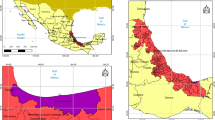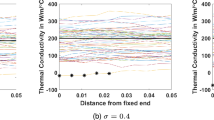Abstract
Air infiltration of buildings has a considerable impact on the energy performance of buildings. Permeability or airflow leakage can be evaluated by introducing the Infiltration Heat Recovery (IHR) factor in the energy balance equation. Conventionally, this factor is computed using a Computational Fluid Dynamics (CFD) software, that is time consuming and not very useful for a fast evaluation of balance energy of a building. This article proposes a Reduced-Order model (ROM) approach to evaluate the effect of the permeability of the energy balance for a building. The ROM, based on the well-known Proper Orthogonal Decomposition (POD) method, is developed in the Modelica modeling language. It is successfully applied to the case study of the air infiltration in the low energy consumption building.
Similar content being viewed by others
References
Abadie MO, Finlayson EU, Gadgil AJ (2002). Infiltration heat recovery in building walls: Computational fluid dynamics investigations results. Technical report, Lawrence Berkeley National Laboratory, LBNL–51324.
Addad Y, Laurence D, Talotte C, Jacob MC (2003). Large eddy simulation of a forward-backward facing step for acoustic source identification. International Journal of Heat and Fluid Flow, 24: 562–571.
Afgan I, Mc Naughton J, Rolfo S, Apsley DD, Stallard T, Stansby P (2013). Turbulent flow and loading on a tidal stream turbine by LES and RANS. International Journal of Heat and Fluid Flow, 43: 96–108.
Allery C, Beghein C, Hamdouni A (2005). Applying proper Orthogonal Decomposition to the computation of particle dispersion in a two-dimensional ventilated cavity. Communications in Nonlinear Science and Numerical Simulation, 10: 907–920.
Allery C, Beghein C, Hamdouni A (2008). On investigation of particle dispersion by a POD approach. International Applied Mechanics, 44: 110–119.
Archambeau F, Méchitoua N, Sakiz M (2004). Code saturne: A finite volume code for the computation of turbulent incompressible flows—Industrial applications. International Journal on Finite Volumes, 1: 1–62.
Aubry N, Holmes P, Lumley JL, Stone E (1988). The dynamics of coherent structures in the wall regions of a turbulent wall layer. Journal of Fluid Mechanics, 192: 115–173.
Axley J (2007). Multizone airflow modeling in buildings: History and theory. HVAC&R Research, 13: 907–928.
Benhamadouche S, Laurence D (2003). LES, coarse LES, and transient RANS comparisons on the flow across a tube bundle. International Journal of Heat and Fluid Flow, 24: 470–479.
Brinks P, Kornadt O, Oly R (2015). Air infiltration assessment for industrial buildings. Energy and Buildings, 86: 663–676.
Buchanan CR, Sherman MH (2000). A mathematical model for infiltration heat recovery. Lawrence Berkeley National Laboratory, LBL–44294.
Carrié FR, Jobert R, Leprince V (2012). Methods and techniques for airtight buildings. Air Infiltration and Ventilation Centre, Contributed Report 14.
Chinesta F, Ladeveze P, Cueto E (2011). A short review on model order reduction based on proper generalized decomposition. Archives of Computational Methods in Engineering, 18: 395–404.
Chorin AJ (1968). Numerical solution of the Navier-Stokes equations. Mathematics of Computation, 22: 745–762.
Dumon A, Allery C, Ammar A (2011). Proper general decomposition (PGD) for the resolution of Navier-Stokes equations. Journal of Computational Physics, 230: 1387–1407.
Dymola (2016). Dymola version, 2016. Available at http://www.3ds.com/products-services/catia/products/dymola/.
Elmqvist H, Mattsson SE, Otter M (1998). Modelica-the new objectoriented modelica language. In: Proceedings of 12th European Simulation Multiconference.
Fritzson P (2011). Modelica—A cyber-physical modeling language and the openmodelica environment. In: Proceedings of Wireless Communications and Mobile Computing Conference (IWCMC).
Gouda MM, Danaher S, Underwood CP (2002). Building thermal model reduction using nonlinear constrained optimization. Building and Environment, 37: 1255–1265.
Han G, Srebric J, Enache-Pommer E (2015). Different modeling strategies of infiltration rates for an office building to improve accuracy of building energy simulations. Energy and Buildings, 86: 288–295.
Huang H, Chen L, Mohammadzaheri M, Hu E (2012). A new zone temperature predictive modeling for energy saving in buildings. Procedia Engineering, 49: 142–151.
Inard C, Bouia H, Dalicieux P (1996). Prediction of air temperature distribution in buildings with a zonal model. Energy and Buildings, 24: 125–132.
Jokisalo J, Kurnitski J, Korpi M, Kalamees T, Vinha J (2009). Building leakage, infiltration, and energy performance analyses for finnish detached houses. Building and Environment, 44: 377–387.
Kim E, Plessis G, Hubert J-L, Roux J-J (2014). Urban energy simulation: Simplification and reduction of building envelope models. Energy and Buildings, 84: 193–202.
Liberge E, Hamdouni A (2008). Reduced-order modelling via proper orthogonal decomposition (POD) for flow around an oscillating cylinder. Journal of fluids and Structures, 26: 292–311.
Maatouk K (2007). A simplified procedure to investigate airflow patterns inside tall buildings using COMIS. Architectural Science Review, 50: 365–369.
Megri AC, Haghighat F (2007). Zonal modeling for simulating indoor environment of buildings: Review, recent developments, and applications. HVAC&R Research, 13: 887–905.
Menes C, Roux J-J, Virgone J (2002). Modelling heat transfers in building by coupling reduced-order models. Building and Environment, 37: 133–144.
Orme M, Liddament M, Wilson A (1994). An analysis and data summary of the AIVC’s numerical data base. AIVC, Technical note 44, UK.
Palomo Del Barrio E, Lefebvre G, Behar P, Bailly N (2000). Using model size reduction techniques for thermal control applications in buildings. Energy and Buildings, 33: 1–14.
Pedras MHJ, de Lemos MJS (2001). Macroscopic turbulence modeling for incompressible flow through undeformable porous media. International Journal of Heat and Mass Transfer, 44: 1081–1093.
Peng X, van Paassen AHC (1998). A state space model for predicting and controlling the temperature responses of indoor air zones. Energy and Buildings, 28: 197–203.
Qiu K, Haghighat F (2007). Modeling the combined conduction-air infiltration through diffusive building envelope. Energy and Buildings, 39: 1140–1150.
Rasam A, Wallin S, Brethouwer G, Johansson AV (2014). Large eddy simulation of channel flow with and without periodic constrictions using the explicit algebraic subgrid-scale model. Journal of Turbulence, 15: 752–775.
RT2012 (2010). Arrêté du 26 octobre 2010 relatif aux caractéristiques thermiques et aux exigences de performance énergétique des bâtiments nouveaux et des parties nouvelles de bâtiments. (in French)
RT2012 (2013). Arrêté du 30 avril 2013 portant approbation de la méthode de calcul Th-BCE 2012 prévue aux articles 4, 5 et 6 de l’arrêté du 26 octobre 2010 relatif aux caractéristiques thermiques et aux exigences de performance énergétique des bâtiments nouveaux et des parties nouvelles de bâtiments. (in French)
Sarkar A, Paidoussis MP (2004). A cantilever conveying fluid: Coherent modes versus beam modes. International Journal of Non-Linear Mechanics, 39: 467–481.
Sempey A, Inard C, Ghiaus C, Allery C (2009). Fast simulation of temperature distribution in air conditioned rooms by using proper orthogonal decomposition. Building and Environment, 44: 280–289.
Sirovich L (1987). Turbulence and the dynamics of coherent structures, part I: Coherent strucures, part II: Symmetries and transformations, part III: Dynamics and scaling. Quarterly of Applied Mathematics, 45: 561–590.
Tallet A, Allery C, Allard F (2015a). POD approach to determine in real-time the temperature distribution in a cavity. Building and Environment, 93(part 2): 34–49.
Tallet A, Allery C, Leblond C, Liberge E (2015b). A minimum residual projection to build coupled velocity-pressure POD-ROM for incompressible Navier-Stokes equations. Communications in Nonlinear Science and Numerical Simulation, 22: 909–932.
Tallet A, Allery C, Leblond C (2016). Optimal flow control using a POD based Reduced-Order Model. Numerical Heat Transfer, Part B: Fundamentals, doi: 10.1080/10407790.2016.1173472.
Tiller M (2004). Introduction to Physical Modeling with Modelica. Norwell, MA, USA: Kluwer Academic Publisher.
Vafai V, Thiyagaraja R (1987). Analysis of flow and heat transfer at the interface region of a porous medium. International Journal of Heat and Mass Transfer, 30: 1391–1405.
Walker IS, Wilson DJ (1993). Evaluating models for superposition of wind and stack effect in air infiltration. Building and Environment, 28: 201–210.
Wang A, Ma Y (2009). An error estimate of the proper orthogonal decomposition in model reduction and data compression. Numerical Methods for Partial Differential Equations, 25: 972–989.
Wang S (1999). Dynamic simulation of building VAV air-conditioning system and evaluation of EMCS on-line control strategies. Building and Environment, 34: 681–705.
Yang I-H, Kim K-W (2004). Prediction of the time of room air temperature descending for heating systems in buildings. Building and Environment, 39: 19–29.
Yao Y, Yang K, Huang M, Wang L (2013). A state-space model for dynamic response of indoor air temperature and humidity. Building and Environment, 64: 26–37.
Yu Y, Megri AC (2014). A novel method for thermostat set point prediction for energy savings and/or better human thermal comfort—A zonal modelling approach. International Journal of Ventilation, 13: 299–318.
Author information
Authors and Affiliations
Corresponding author
Rights and permissions
About this article
Cite this article
Tallet, A., Liberge, E. & Inard, C. Fast POD method to evaluate infiltration heat recovery in building walls. Build. Simul. 10, 111–121 (2017). https://doi.org/10.1007/s12273-016-0306-3
Received:
Revised:
Accepted:
Published:
Issue Date:
DOI: https://doi.org/10.1007/s12273-016-0306-3




